Sauropod Swindle! The Monstrous Lies of "The World's Largest Dinosaurs"
by Caroline Bankoff and Jonathan Liu
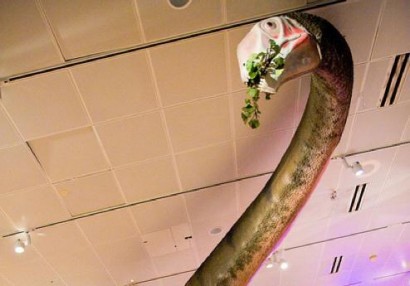
“Leave it as at is,” Theodore Roosevelt once said about the wonders of the Precambrian: “The ages have been at work on it, and man can only mar it.”
What a scandal that the institution co-founded by his father — and with Teddy Roosevelt’s own outlandish equestrian statue out front, flanked by Red Indians — would prove the great man so pitifully right about history. (And in 2011, no less: the centennial of his legendary Bull Moose break from the Republican Party.)
The World’s Largest Dinosaurs — which opened at the American Museum of Natural History on April 16th and plays (if that can be the word for this inert, child-sneering exhibit) through the year — purports to ask, “How did the biggest sauropods get so big?” This is a timely question, a noble one. Sauropods were the largest dinosaurs (hereafter: dinos), and thus the largest land animals, the planet has ever hosted. They are the brontosauri of our collective youth: impossibly long-necked, long-tailed and tiny-headed quadrupeds. When parked offshore, the other animals would always comically confuse them for islands.¹
And yet, as exhibit and enterprise, The World’s Largest Dinosaurs is dominated, tail-tip to premaxilla, by the profoundest sense of smallness. It is indeed physically small — shoehorned into the fourth-floor gallery last inhabited by Extreme Mammals! There are likely classic sixes in the immediate neighborhood with more square footage. The stars of Extreme Mammals! were a group of actual, living sugar-gliders (possum-like monsters less than 150 grams each). That was appropriate. The star of The World’s Largest Dinos is a female fiberglass Mamenchisaurus (she tweets as @Giant_Dino), whose neck — at some 30 feet — is billed as the longest of all dino necks. Presented with foliage jutting from her mouth, she has to stoop to fit into the space, which is fashionably black-boxed and track-lit. Still, she makes an unimaginably winsome centerpiece — wearing, on her barely-there face, a look between bemusement and mortification at her predicament — while aggressive crowd-flow measures keep lanes clear of too many human children. But if you look beyond that face you see that the real crippling, scornful smallness of The World’s Largest Dinosaurs is conceptual and, finally, moral.
As dino-lovers and museum curators, we tend to be supremacists — and wishful thinkers. Perhaps it’s our bipedality, perhaps it’s the bloodlust, but for too long human beings have constrained our fellow feeling to the vultures and jackals, the terrorists and hysterics, of the dino world. A boy who pretends to be a Tyrannosaur is liable to be made quarterback or goalie (despite his terminally short arms). One who playacts Velociraptor tends to be tracked into college-prep courses and have his internet use monitored. But he who wanders around peacefully as Brachiosaurus or Diplodocus is suspected of autism, or worse. And yet we people aren’t carnivores, not really. Indeed, with ever more, and ever-fatter, human beings — beings, in this country at least, made almost entirely out of corn — it will be the plant-munching sauropod, if any dino at all, that offers us deliverance. Certainly not the gym-toned hunter-killers who by all accounts threw in their lot with the birds long ago.
But our deliverance will have to wait. Housed in Teddy’s temple to taxonomy and taxidermy, the new exhibit doesn’t answer the Sauropod Question so much as pose a stream of new, darker sauropodian questions: When did this biggest city’s biggest cultural bulwarks get so theropod-craven? How was the public’s inborn need, and love, for dinos so thoroughly co-opted by commerce and ideological coercion? Darkest of all, can a new generation be made to understand the awesome majesty of these creatures in the face of the seeming dereliction of duty of every independent guardian of dino propriety?
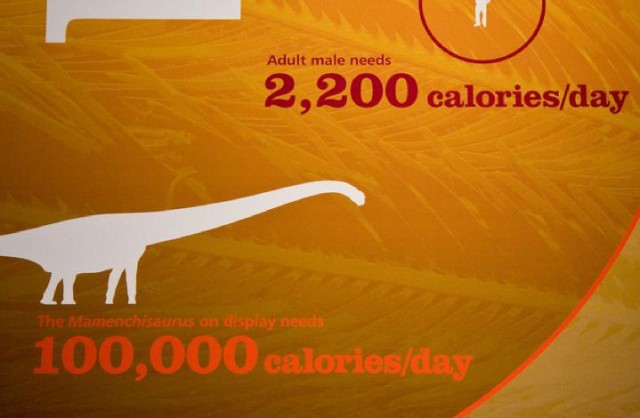
At base, the failure (and the scandal) here is not one of quantity, though emerging from the exhibit twenty minutes and a few hundred feet after entering, one’s outrage rather naturally centers on these numbers — and other numbers more offensive, to which we will return shortly. With reflection, any responsible critic avows that a phenomenal dino experience need not be particularly large, or long, or even expensive to create. (We, as you, could mount an entire show around just one of AMNH’s own dino-bird transitional specimens.)
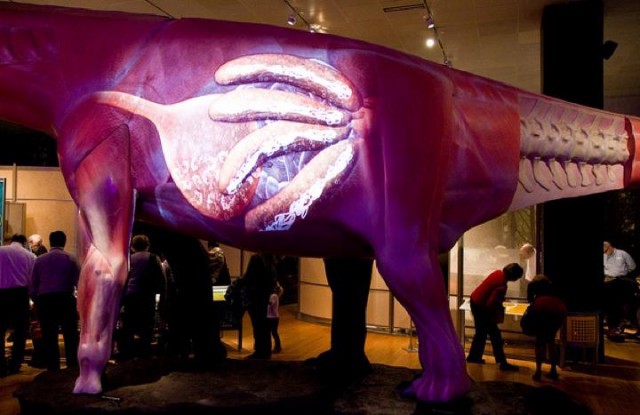
Appreciating the gravity of the show’s crimes will necessitate a brief detour into dino history — or rather, dino historiography. As you’ve no doubt suspected, dino remains dug out of the ground are not made of fiberglass, like Ms. Mamenchisaurus. Likewise, these remains wouldn’t usually include skin and flesh and faces, or cutaway sections on which to project videos of her internal organs. That a big-event dino show might be built around an obviously pre-fab model of a dino is an artifact of the Dinosaur Renaissance, which has run more or less alongside the passages of feminism and civil rights and generative linguistics since the late 1960s. In this period, radical paleontologists — most famously John Ostrom and his student Robert Bakker² at Yale — began upending scholarly and popular assumptions about the dinos (preserved in such usages as “Chrysler is a Detroit dinosaur”), in the process making them worth studying again.
In other words, a child learning how to speak is not to be considered a process no more exciting than a dog learning how to fetch, and also dinos weren’t lumbering, stupid lizards writ large, but extremely active, maternal, perhaps warm-blooded, and above all bird-like. (Think eagles and ostriches, not sparrows and pigeons.) Massive new dig sites in Patagonia, Mongolia and especially China — where dino finds, like many growth industries, support a lively trade in counterfeits — have revealed features like feathers, nests and wing-y things for some of them. Meanwhile, scientists in a number of fields have mostly settled on an impact theory for the K–T Extinction, meaning it wasn’t really dinos’ fault that such a mess happened to them 65 million years ago (quite unlike, say, Chrysler). In fact early therapsids, the group that would eventually become mammals, were basically hegemonic on land by the Permian (around 250 MYA) until the previously obscure dinos snatched the evolutionary crown away from them (us).
So a field of inquiry that used to be mostly about geology or, worse, curiosities — it’s time to ask: would people flock to museums to see a polyurethane replica of King Tut’s sarcophagus or a cubic zirconia knockoff of the Hope Diamond? — is now a matter of behavior, ecology, personality.
We applaud the growth away from fossil essentialism. It is past time that non-specialists have access to a dino gestalt greater than the sum of so many ossified little parts. That TWLDinos features very few actual, newly discovered traces (“indexical” signs, to use crypto–dino-lover C. S. Peirce’s terminology) of sauropod life — among these few, a really large femur, and some fossilized feces — is not at issue. That is how an extensive, modern-day dino tale (and tail) must be told. What’s egregious, shameful, is that the exhibit wraps itself in the progressivism of the Dinosaur Renaissance (sweet Ms. Mamenchisaurus!) to hide what’s really a medieval insouciance to facts, prose, aesthetics, interest.
If the intellectual project is to move beyond the atomization of sedimentary strata, to bring together, in the words of TWLDino’s website, “scientists from many fields…to discover what made [sauropods] tick,” why is the second largest single attraction here a mock fossil bed over which visitors armed with picks and brushes are meant apparently to experience the dull workday of the lowliest intern at some godforsaken “badland”? How is simulating the circumstances of the discovery of its calcified corpse a hundred million years hence germane to understanding how an animal lived and loved and died?
Perhaps the revelation is this: to watch parents and offspring gravely chiseling away at artificial sand in search of absent meaning is to see something of the despair a real Mother Mamenchisaurus must have felt for its kin and kind as, after first impact, the atmosphere caught fire and the lights went out in dino world, not to be seen again in any non-avian lifetime. For the visitor, the bathtub of fake dino bones is not merely a waste of space. It is a time sink — the most attenuated form of “interactivity” pantomiming as genuine engagement.
There are still some gee-whiz, infotaining moments. A Plexiglas cube containing the volume of roughage a male sauropod is said to have eaten per hour was appetizingly, empathetically mesclun-like, and from certain angles a surprisingly sensible-looking portion — though the authors are, for primates, emotional binge grazers. There is the matter of that very large femur, which the exhibit makes a show of putting into the context of more familiar skeletons, largely those of present-day ungulates (the hoofed mammals).³ But this context quickly devolves into a carnival game–cum–algebra quiz. A hideously oversized console asks the visitor to measure her own femur, then enter the length via digital dial. Then the machine will spit out her approximate body weight, were she transformed into a sauropod with her femurs unchanged. What is this meant to prove? Given the exponentially disparate rates of change as a body’s length, surface area and volume increase, the relation between limb length and body mass is nothing like linear. But to piece together some semblance of the actual question being hinted at here — that is, how must a three-dimensional measure of biology explode to account for seemingly small growth in a single dimension? Or, how did the world’s biggest dinosaurs get so big? — means, at the very least, entering a series of femur lengths in order to reverse-engineer the algorithm hidden beneath the LED displays. Even the professional mathematician is likely to be besieged by impatiently waiting children before extracting enough data to get anywhere close.

And, even as a parlor trick, how dispiriting! Sideshow weight-guessers at least have the decency to know undershooting the mark is never unprofitable in the long-run. We duly measured one of our four thighs — 38 centimeters — and were told we deserved to weigh 393 pounds. The cruelty here is unmistakable: why else ask for length in pedantic metric and announce weight in wanton Imperial?
But let us distinguish between the venal sins of curation — we nearly expected them to try “Let the computer guess your age in sauropod years!” — and the mortal, the deeply malicious and mendacious. In the end, the only true windows into any museum’s soul are small, rectangular, black-and-white and textual.
Let us mince no more words (nor roughage): wall text. One obviously does not expect, on the walls of an exhibit called The World’s Largest Dinosaurs, to find the hermeneutic nuance of a Frick Collection, or the dialectical rigor of a Neue Gallerie. One does expect, whether one is 7 or 70, not to be overwhelmed by words that range from infantilizing to evasive to meaningless to, in the end, viciously mocking.
The infantilizing, evasive, and meaningless first. The introduction to the sand pit offers this inspirational notice:
Finding fossils is the first step to learning about sauropods
To figure out how sauropods moved, breathed, or ate, paleontologists need fossils. For example, we know a great deal about Mamenchisaurus, shown at life size in the previous gallery, because of fossils uncovered in China. Fossil expeditions around the world have uncovered the remains of hundreds of sauropod species. Large numbers of sauropod fossils have been found in Wyoming, in the Western U.S., at a site called Howe Quarry.
Forgive for the moment that we are being asked to identify this particular tub o’ bones with a real world quarry in “Wyoming, Western U.S.” (a site much better known for its apex-predating Allosaurs than sauropods.) Rather, let us consider the rather perverse distortions of scientific process and progress this breezily insouciant text might impart on the child, or childlike adult, unschooled in the post–Dinosaur Renaissance intellectual history.
Would we countenance this: To figure out how, formally, Ulysses moves, breaths, and signifies, critics need books. Book-buying expeditions around the world have uncovered the remains of hundreds of Ulysses printings. For example, we know a lot about the “The Telemachiad,” rendered life-size on the previous Kindle, because of a 1990 Vintage paperback from the Strand’s Central Park Kiosk?
In other words, none of the physiology, or the feeding and breeding behavior — or, indeed, even any of the soft tissues — highlighted in Ms. Mamenchisaurus is simply manifest in the bones; that, we’ve seen, is the supposed point of this modern addendum to the Museum’s lode of jigsaw-assembled beasts. If the Howe Quarry wall text were truly invested in the exhibit’s epistemo-interpretive bases — how we figure out how — it would have to address theoretical apparatus with at least the seriousness of the average Joyce scholar, and probably much more. Upon the fossils themselves, from China or around the corner at 60th and Fifth, what regime of close-reading shall count for truth? What combination of x-rays and P.E.T. scans, carbon dating and electron microscopy, get at the mysteries of moving, breathing, eating?
Moreover, by what operations of analogy, synecdoche and extrapolation are the bare bones of a single species, or a single specimen, related to animal life as such? Sauropod fossils are sauropod fossils. The first steps — in a sense the only “step” — to learning about sauropods per se, as a type of really big dino and land animal and friend, are the methodologies and meta-methodological assumptions in the scientific transubstantiation of thing to fact to concept. What do these parts of Ms. Mamenchisaurus mean, in light of all we already know about all the parts of all other creatures? Why is it that the long sauropod neck, originally thought to serve as a sort of scuba tube for wading giants, and later as a way of niche-feeding on the tallest trees, is now understood to be evolutionary optimized for browsing — to sweep across the leaves, whether near or far, high or low, without having to move one’s main hulking bulk? To truly know this is to know the bleeding edges of biomechanics, stratigraphy, geomorphology, hepatology, hematology, herpetology, ornithology and ontology. Again, no one expects TWLDinos to give its visitors all that; a museum is no Wikipedia. But do not use words — and not just words but wall text, the scriptural basis of our civilization — as lowest common denominator, a blunt non-explanation where there is no natural, logical connection between the science and the sideshow.
Given the most meager scenes to describe, we might imagine the uncredited prose artists of The World’s Largest Dinosaurs as mere bystanders, incredibly lazy (“we know a great deal about”?) but only by dint of being justifiably bored. As it happens, the pen truly is mightier than the trowel; their insolence cuts to the bone. Quite at the (physical and moral) center of the exhibit, an odd glass case beckons the passerby to place his face up to two eyeholes. The skin of a very small, very schematic model of a generic sauropod suddenly goes from solid dun to something stripier and patchier, like trees. The point of this little sub-zoetrope exercise? Ostensibly, to confirm that, even the largest animals might — might — benefit from camouflage. This is a revelation? Had they not thought we had already noticed that the famed blue whale in the Museum’s famous blue whale hall is not in fact yellow-and-vermillion paisley but blue, like the ocean it was harpooned from?
Pull away from the non-sequitur peepshow, and all begins to make sense. The bizarre interlude about camouflage is just a set-up for this sucker-punchline, direct to the audience’s sense of wonder.
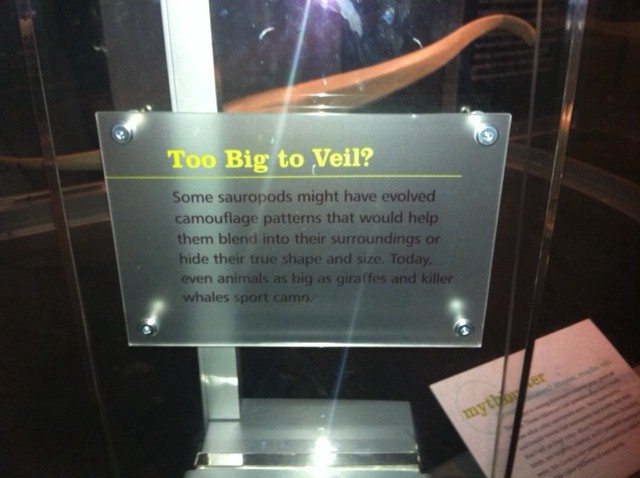
You may see a series of squirmy conditionals after the pun — “some,” “might have,” “would have,” “helped” — but make no mistake, what you are reading is sdjkhahahaha ROFL k thx die.
“Too Big to Veil”! A taunt, and a flaunt. The World’s Largest Dinosaurs has, quite uniquely for an exhibit of this promotional scale, just one name sponsor: Bank of America, which is a commercial bank and much else besides. By contrast, Extreme Mammals!, its immediate predecessor, boasted the scrupulously philanthropic Lila Wallace-Reader’s Digest Endowment Fund, the Bill and Ann Ziff Foundation and Harlan B. Levine, MD and Marshall P. Levine, grandsons of a past president of the San Francisco Museum of Modern Art. (These and other Levines are “additional supporters” of dinos.) Curatorially, Mammals! was a joint venture with the California Academy of Sciences, the Canadian Museum of Nature and the Cleveland Museum of Natural History.
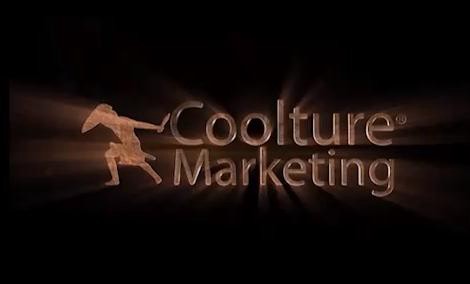
But TWLDinos stems from a “collaboration” with an outfit called Coolture Marketing out of Bogota, Colombia. Surely staffed with masters of multichannel brain invasion, Coolture seems curiously short of Anglophones for a firm that came up with the pun “Coolture”: “Recapitulate,” its website suggests regarding the show they call “Dinosaurs Era,” “the evolution of the beings that have inhabited our planet, has been possible until now through written registries, fossils, among others.”
“Captivating the general public,” Coolture explains, more generally, “is another priority. Because of this, our assemblies are designed so that one same space, education, culture and entertainment can be conjugated; three elements that seduce the common of the spectators and that make art a more accessible expression.”
We do not imply that commerce and dinos should not mix or that we do not want our commons seduced. It’s hard to imagine our combined 50 years of dino-conjugation without the interventions of untold script doctors and CGI techs, plastic mold–injectors and stuffed animal–stuffers. If Google or Boeing or even Walmart wanted its corporate culture to bask in the overflow glow of sauropod giants, the connection might seem natural and as apolitical as cultural sponsorship can be; imagine Aflac insurance or Duck Brand duct tape funding the next big hadrosaur show. Bank of America standing behind sauropods stretches the metonymic resemblance to a moral one: It’s not our fault. [Disclosure: We own a combined 55 shares in Bank of America, and we don’t wish to talk about it.]
So truly exciting, generation-defining insight into sauropod physiology is recast as apologia: Less how the largest dinosaurs got so big so much as why it’s okay that they are. Even poor Ms. Mamenchisaurus is drafted into the campaign. As her internal organs come to life along her left flank, a voiceover tells us not to be too awed by the awesome spectacle of her dirigible-like cardiopulmonary system chugging away: “Sauropods most likely owe their gigantic size not to one trait, but a unique mix of many… a patchwork of evolutionary innovations.” As a statement about dinos, this manages to be both deeply tautological (is there any gigantism, excepting possibly that of the ego, that doesn’t implicate multiple traits?) and faintly false; TWLDinos itself attests, in its more sober corners, that radical changes in scale don’t just accrue arithmetically around the body, but become, necessarily, a difference in kind.
For all it fetishizes thundering thighs and huge salads, the exhibit rather willfully fails to explicate size qua size, that alien grandeur that draws us ever tighter to dinos, post-Renaissance. Their curious humanness isn’t something that mitigates their inhuman proportions, but rather aggrandizes the imaginary potential of human sapience — any child can tell you that’s why she loves dinos. It is difficult not to read in TWLDinos’ appeal to “a patchwork of evolutionary innovations” a defensive ambivalence toward size that is finally more political than paleontological.
Isolating overgrown “traits” as individual, localized developments from some more “natural” crocodile- or bird- or mammal-scale is to deny sauropods the singular power — and thundering responsibility — of their hugeness. If the brontosaur’s heart is really no different than a chicken’s when it comes down to the chambers, the valves, the pumping, then B of A is clearly just a friendly up-scaling and streamlining of the Main Street bank in taking savings and making loans, and, perhaps, maximizing value in its own proprietary operations on the side.
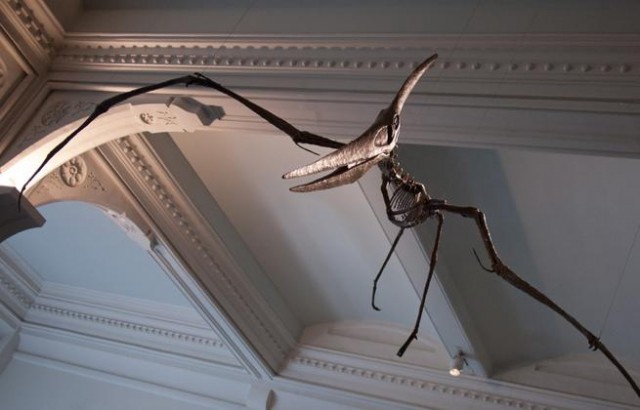
One suspects The World’s Largest Dinosaurs will, by the end of the fiscal year, have seared itself deep onto the credits column in more than one organization’s ledgers. Many museum collections — every Guggenheim’s, for eight — aren’t worth the price of admission. The true genius of AMNH, B of A and TWLDinos is in having defrauded patrons leave feeling enthralled. Call it ticketing-floor arbitrage: Laudably, the Museum still maintains a variable entry-price policy, with a suggested donation of $16 for adults. Intend to see a “special exhibition,” however, and that $16 becomes mandatory, plus $8 for said special. Entry to TWLDinos alone is thus, theoretically, as high as $24 per person. Parents — nay, entire school districts — across the tri-state area would be in open revolt if they and their children experienced the transaction for what it is: roughly a dollar a minute for disjointed, mildly animatronic discourse on sauropod ephemera. Instead, TWLDinos is cannily situated as a dark-room pit-stop between the permanent galleries devoted to ornithischian and saurischian dinos, respectively. But those stunning, sun-drenched fossil halls still have the power to shock and awe even the most jaded stoner or sixth-grader, and at the end of the day it’s the t-rexes and raptors and pterosaurs there that will be what any casual visitor remembers about the Museum’s dino offerings.
Is baiting visitors with promises of brand-new World’s! Largest! Dinosaurs! and then switching their wonderment to the old bony standbys, technically available for $0, thus something of a victimless crime? Sure! As long as you don’t believe in the life of the mind. For what the innocent child takes away from such chicanery is precisely what decades of Dino Renaissance purports to correct: As flesh and blood and intellect, these animals are dreadful, parsimonious bores; they only come to life when reduced to bones. How can the luminaries of dinoscience, who’ve nary a bad word to say about TWLDinos, live with themselves?
We understand the great personal and professional danger we place ourselves in by even questioning the propriety — the decency — of this dreadful enterprise in a city seemingly transfixed by the worst instincts of dino commodification. We offer this extended account of the problem here with the recognition that, upon publication, we’re likely never to write about dinos in this town again. How else but pure, lizardly coercion to explain the ubiquitous media misinformation that’s accompanied the sauropod subterfuge? “Dino-Might!” blared the headline of Alisa Wolfson’s April 16 New York Post review. Up top she absurdly called the show a “super-sized exhibit”; the next paragraph tells us its Argentinosaurus model is “so huge, curators were able to show just its head and part of its neck, the only sections that would fit in the room” — as if the rest of the creature were sitting in Dia:Beacon, waiting for New York City to finally build a space big enough for him.
Writing in the Times, Edward Rothstein had the courage to call the faux fossil pit “a bit pointless,” but only as postscript to praise: “What is so successful about this exhibition is not found in such installations, but in the way it treats scientific ideas. The show is really a demonstration of deduction, yet nothing about it is abstract or arcane. Its panels are crisp and clear. And they show contemporary paleontology to be an adventurous conceptual enterprise.” We challenge Rothstein to show us the deductive rigor undergirding the camouflage text or the thigh-guessing game; if this be crispness, give us obliquity.
But the season’s most definitive bit of paleontological Pravda may have been the April 17th Daily News staff editorial, freed from any residual burden of shame by the absence of byline. AMNH is, in the space of less than 300 words, called “an amazing institution,” “a world-class operation,” and “a place of high science and instruction” with “an awful lot of brain power.” “Visit,” it finally insists, in the imperative. “You will learn and be wonderstruck.” The editorial’s headline begins “American Museum of Natural History has outdone itself…” and one can’t help but agree.
Such is the shame of the museum, where the cannier schoolchildren are, as you’re reading this, picking up the latest perversion of republican virtue: Speak insipidly and carry a huge femur. But just one, or as few as you can get away with.
¹ N.B.: We believe the disenchantment of the world begins with the incessant hypercorrection of Brontosaurus (“thunder lizard”) to Apatosaurus (“deceptive lizard”), and will not follow that convention here, or anywhere.
² Bakker’s 1975 Scientific American article “Dinosaur Renaissance” is to dino life what Chomsky’s 1959 “Review of B.F. Skinner’s Verbal Behavior” is to human language.
³ A word about elephants, specifically those in the room.

Like Jerry Falwell, we fantasize about an earlier, better world, one in which dinos and humans lived alongside one another in harmony interrupted by the occasional epic battle. We secretly mourn the closing of Pensacola’s Dinosaur Adventure Land, a project of Young Earth creationists, which we’d have gladly visited had we come up with a way to avoid paying the admission fee. (Our sympathies with the movement begin and end with dinos). Our trip to the Museum included no such plans, happy as we are — or perhaps, were — to believe that the spirit of good works could be trusted to use our occasionally hard-earned dollars in good faith. We raised an eyebrow as the pay-as-you-wish of General Admission spiraled to the $24 of “Special Exhibition”; we batted an eyelash and froze our incipient frown lines and crow’s feet to get it down to the student $18. We would soon come to regret our idealistic spendthrift-ing. Our charming ticket agent, noticing that we might be able to understand Chinese, said something in pidgin mandarin that sounded like “Ni hao ma?” that we cannot not now interpret as “beware.”
Tickets in hand, we entered the central Hall of African Mammals, where we were greeted — like Holden Caulfield and Ben Stiller before us — by the proud herd of African Bush Elephants sashaying down the rotunda. (It would later be revealed, in despondent post-dino conversation, that one of us had never read A Catcher in the Rye or, for that matter, Gatsby. He insisted that there was no point in doing so now, as he already gets, and makes, all the references.) Unlike their continental brethren — the bongos and impalas and mandrills — sealed behind (one-way?) diorama glass, the Museum’s elephants are elevated and open-air, cordoned off by low banisters. You can touch them, though you aren’t supposed to. The high ceilings and dim light and the vague, not-unpleasant chlorine-and-dust smell were reminiscent of other halls in which we’d spent similarly bright spring afternoons of our even youthier youths: those of the college library. The climate encouraged us to recall the free-association of finals season when, having set aside any pretense of learning for the sake of long-term retention, let alone knowing, we scanned texts and lecture notes for whatever tenuous word-weddings — the problematization of this, the deconstruction of that — might birth a more or less legitimate (in the sense of unplagiarized) .doc child to email to our long-suffering educators, its timestamp always just under ten minutes after the assigned deadline, a testament to our punctiliousness, unbeholden to mere punctuality.
Having long since been weened, and pedigreed, from the puppy mill of American higher education, our trip to the Museum was a much purer exercise, an endeavor undertaken in the true Pursuit of Knowledge, or in any case a safe legal high. There was, therefore, no danger in the indolent whimsy of our thoughts. Supine (quite separately — eww!), riding a lazy river of the mind, we contemplated the similarities between dinos and elephants. Mostly — perhaps exclusively — that they are both very big, though dinos are bigger. Elephants are smarter, we know, but dinos are better. We dream of dinos, but we live — fitfully — with elephants. (The Bronx Zoo plans to phase out its elephant enclosure as its inhabitants, three forlorn Asian specimens, die, and they are the last elephants in New York City, although there are currently five GOP members on the City Council.) Prior to entering the special exhibition, our time with the elephants seemed but an enticing permanent-collection amuse-bouche to prep our sense(s) of awe for the Ferran Adrià sauropod feast to come.
Imagine our confusion, then, as we encountered another — and, in what would turn out to be the spirit of TWLDinos, a rather less strapping — elephant almost immediately upon entering the exhibit. Here was the skull of an elephant, here was the skull of a sauropod: did we see that it was bigger? Well, sort of. Staring at the graying craniums, emptied of all signs of brains, of a comically long-nosed creature said to mourn its dead and a comically long-necked one with a lot of dead to mourn, it was suddenly more difficult to say which was better. Eagerly, we moved along. There was lots, we thought, more to see.
But then again: here was the femur of an elephant, here was the femur of a dino. Yes, the dino femur was bigger but, you know, not that much bigger. Here was where, as noted above, we were invited to measure the length of our thigh and enter it into a thigh-calculation machine. Were we a dino, we would weigh 393 pounds. We could not help but note that there were people, right here in this very city, who weighed even more than that. If we were dinos, we’d be dinos, and we’d weigh quite a bit more than 393, thankyouverymuch. The depressing reality of our lowly human lives — our sad little human size, the tiny dull teeth with which we chew the food that either will or will not result in poundage verging on 400 — has nothing to do with our lives as dinos.
And then we were presented with a model of a fetal elephant alongside many dino eggs and a hatchling. “Sauropods reproduced like many living reptiles. But most large animals, like blue whales and elephants, take another approach. What’s different?” In a world of giraffes and ostriches and armadillos and komodo dragons and Donald Trump, why the fixation on comparisons with an animal, we’re told again and again explicitly, is not that much like sauropods? This, perhaps, was when our disappointment finally burst into recognition, and even a certain awed respect. The temerity of it all! Even the most virtuosic fantasy artists of our student days would be alarmed by such swaggering, keg-stand source abuse — I could only make it through the 1957 monograph on elephants before Texas Hold ’Em time; no matter, through sheer force of will, I will make it sound like elephants and only elephants are relevant to the assignment. If this were a school paper, the bounder would hope that the TA, like all toddlers, would confuse the trunk for the neck, and grade inflation would do the rest.
Eventually we retired to that elevated stone sandbox packed with mock-fossils, accompanied by a cart of chisels and brushes with which to excavate them. Goggles were also available (insurance-mandated?) though we did not make use of them. We took our place alongside our new colleagues, half our size, and joined them in their existential crises. It only took a few minutes for us to give up and make our way into the gift shop at the exit of the exhibit. (This is not the same gift shop as the gift shop at the entrance of the exhibit.)
The dinos had been brought back down to earth. But not in the way we wanted. We left, back through the elephant hall — just another day, another waste of time and space, another excavation of unspeakable loneliness.
Caroline Bankoff lives in New York. Jonathan Liu reports and reviews for various outlets, and tumbles as endasher.
Pterosaur photo by Tyler Karaszewski. Calories per day, dino head, dino organ projection and giant salad cube photos are by Garrett Ziegler from Flickr.
